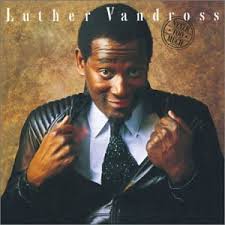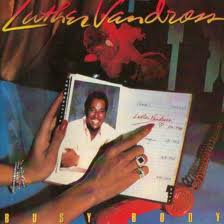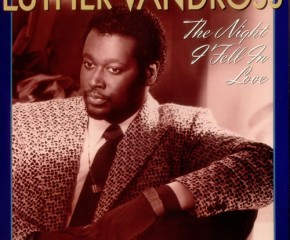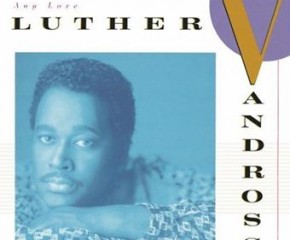In July 2005, one of the most exquisite voices in music history was silenced. When Luther Vandross passed away at the age of 54, we were robbed of our generation’s Sinatra.While some would question that comparison, the two had more musical similarities than differences. Both preferred subtle shading to vein-popping histrionics. Both men had a way with a ballad. Both men wore their hearts on their sleeves vocally. Both were master interpreters of other peoples’ material (although of the two, Luther wrote material on his own that was just as good.) Hell, both men hail from the Tri-State area (Sinatra from New Jersey, Luther from the Lower East Side.) It wouldn’t be too far of a stretch to imagine Luther headlining in Vegas had he lived, or doing the type of Great American Songbook album that rocketed to popularity shortly after he had his 2003 stroke.
Over a solo singing career that spanned over twenty years, the delicate way in which Luther interpreted lyrics gained the vocalist a legion of dedicated and faithful fans. Whether delivering a bubbly dance tune, a sobering message song, or (his forte) classic ballads, Mr. Vandross was a vocalist who was practically unequalled in passion and sensitivity-a testament to good taste in idols (Dionne Warwick, Diana Ross, Aretha Franklin and The Temptations.) Luther started out at the tail end of the disco era and retained his popularity through Minneapolis funk, new jack swing and gangsta rap. Far from just a vocalist, Luther was a master vocal arranger, background singer, commercial jingle vocalist, live performer (his shows are legendary), songwriter and producer. His work can be found on songs ranging from David Bowie’s “Young Americans” to Chic’s “Le Freak” to Sister Sledge’s “He’s the Greatest Dancer” to Stevie Wonder’s “Part-Time Lover” to Richard Marx’s “Keep Coming Back.”
Not just a soul man, not just a ballad singer, not just a master of love songs, Luther’s discography reveals a stunning body of work that holds up strongly two if not three decades after release. Sit back, light a candle (if you’d like) and read on as we sail through the career of the man best described by one of his many nicknames-“The Voice.”
Part 1: The Eighties
 Never Too Much (1981): Luther wasn’t really a newcomer when his first album was released in the fall of 1981. Not only had he toiled for nearly a decade as a background and jingle singer, but he’d also released two albums as part of a collective called Luther (unfortunately, Vandross bought back the rights to both albums and never re-released them.) Additionally, he’d scored a pair of hits the year before as the voice behind disco outfit Change. So, audiences were already familiar with the voice even if they didn’t know the name behind it. Never Too Much ensured that the name “Luther Vandross” would be identified with that voice from the day of its release forward.
Never Too Much (1981): Luther wasn’t really a newcomer when his first album was released in the fall of 1981. Not only had he toiled for nearly a decade as a background and jingle singer, but he’d also released two albums as part of a collective called Luther (unfortunately, Vandross bought back the rights to both albums and never re-released them.) Additionally, he’d scored a pair of hits the year before as the voice behind disco outfit Change. So, audiences were already familiar with the voice even if they didn’t know the name behind it. Never Too Much ensured that the name “Luther Vandross” would be identified with that voice from the day of its release forward.
With eight solid tracks and platinum sales, Luther established himself as a force to be reckoned with. The mix is bass-heavy on the uptempo tracks, not least due to the influence of future bass legend Marcus Miller. “I’ve Been Working” and “She’s a Super Lady” don’t skimp on the bottom, running contrary to Luther’s later reputation as strictly a balladeer. The smoky “Don’t You Know That” echoes George Benson’s Quincy Jones productions from the same time period, and is a standout. However, two tracks here cemented Luther’s legend. “Never Too Much”‘s title track still sounds fresh 32 years later, with a peppy groove, witty lyrics and Luther’s rap-like cadence, while his cover of the Bacharach/David chestnut “A House is Not a Home” is the definitive reading. Luther infuses the song with a sadness and despair that’s piercing without being the least bit melodramatic. When Vandross passed away in 2005, this was the first song I played.
All in all, one of the decade’s best debut albums. It seems ridiculous in retrospect that he lost that year’s Best New Artist Grammy to Sheena Easton. (A-)
Forever, For Always, For Love (1982) : Luther’s second album wasn’t much more than a slightly subtle re-do of his debut, but lightning can strike the same place twice, and I’d even argue that while no song on Forever hits the heart as much as “A House is Not a Home” does, as a whole, it’s a better album than Never Too Much. Luther does slow the pace a bit, and even the uptempo songs (like the bouncy “You’re the Sweetest One” and the almost-corny “She Loves Me Back”) are a little more relaxed than the faster sides on his debut. “Promise Me” might be his best mid-tempo groove song ever, and “Bad Boy” (combined with Sam Cooke’s “Having a Party”) is the perfect song for starting off that barbecue or basement jam. Elsewhere, Luther tries to do for The Temptations’ “Since I Lost My Baby” what he did with “A House is Not a Home” and almost succeeds; the result is great but not Earth-shaking. You can’t go wrong with any of Luther’s first few albums, but this should be first or second in the bunch. (A-)
 Busy Body (1983): 1983 was the year black pop broke big, with the success of Michael Jackson’s Thriller, Prince’s 1999, and the first two Lionel Richie albums, not to mention the comeback effort that was Marvin Gaye’s Midnight Love. Luther may have felt some pressure to compete with the crossover success that those artists experienced, which might be why Busy Body is somewhat more dance floor-oriented than its predecessors. Regardless of the tempo increases, though, Busy Body is still very much a Luther album, and if there’s a sleeper in his catalog, this one might be it.
Busy Body (1983): 1983 was the year black pop broke big, with the success of Michael Jackson’s Thriller, Prince’s 1999, and the first two Lionel Richie albums, not to mention the comeback effort that was Marvin Gaye’s Midnight Love. Luther may have felt some pressure to compete with the crossover success that those artists experienced, which might be why Busy Body is somewhat more dance floor-oriented than its predecessors. Regardless of the tempo increases, though, Busy Body is still very much a Luther album, and if there’s a sleeper in his catalog, this one might be it.
“I Wanted Your Love” and “I’ll Let You Slide” are two shiny, synth-drenched productions that work despite production that’s now just a little dated. “For the Sweetness of Your Love” fares better, as it has a bit more of a funk vibe and Luther also lets himself cut out towards the end of the song (where he vows to fight Mr. T for the sweetness of…well, you get the idea.) There’s also the stunning “Make Me a Believer.” Although he scored his only top 40 pop hit from this album with the borderline-treacly Dionne Warwick duet “How Many Times Can We Say Goodbye?”, Busy Body is best known for featuring Luther’s outrageous cover of The Carpenters’ smash hit “Superstar.” Barely a year after Karen Carpenter’s death, he turned one of the corny (but oh-so-good) pop duo’s biggest hits into a stone soul classic. If anyone thought “A House is Not a Home” was a fluke, they definitely thought twice after hearing this. (A-)
 The Night I Fell in Love (1985): Luther’s first multi-platinum album, The Night I Fell in Love confirmed the singer’s superstardom and remains one of his most highly regarded albums. While all of the Luther hallmarks are there (including amazing covers of Brenda Russell’s vulnerable “If Only for One Night” and Stevie Wonder’s “Creepin'”) there’s also “‘Til My Baby Comes Home,” an uptempo ditty that was his most Top 40-centric tune to date (and it worked…Luther scored his biggest pop hit to date with it.) I can remember almost every song on this album getting airplay at one point (barring “My Sensitivity (Gets In the Way)”) which is a pretty accurate barometer of how much of a staple it was through 1985 and into the early part of 1986.
The Night I Fell in Love (1985): Luther’s first multi-platinum album, The Night I Fell in Love confirmed the singer’s superstardom and remains one of his most highly regarded albums. While all of the Luther hallmarks are there (including amazing covers of Brenda Russell’s vulnerable “If Only for One Night” and Stevie Wonder’s “Creepin'”) there’s also “‘Til My Baby Comes Home,” an uptempo ditty that was his most Top 40-centric tune to date (and it worked…Luther scored his biggest pop hit to date with it.) I can remember almost every song on this album getting airplay at one point (barring “My Sensitivity (Gets In the Way)”) which is a pretty accurate barometer of how much of a staple it was through 1985 and into the early part of 1986.
At this point, Luther knew what his pocket was yet he still had a freshness to his sound. “It’s Over Now” was a jammin’ dance groove with a monster bassline, while “Wait for Love” was one of his most haunting yet hopeful ballads. I’d be remiss if I didn’t take a second to mention his faithful backing vocalists (led by Cissy (Whitney’s mother) Houston and including Darlene Love and Chic’s Alfa Anderson,) whose soaring voices help make that particular song what it is. Yet another satisfying album in a string of excellent sets that launched Luther’s career. (A-)
 Give Me the Reason (1986): The Night I Fell in Love afforded Luther his greatest success to date, and he fully expected Give Me the Reason to take him to the proverbial “next level.” It certainly wasn’t a failure-the album became his second straight multi-platinum seller and fifth consecutive platinum album overall. It also contained the effervescent “Stop to Love,” which became Luther’s first top 20 pop hit (and second #1 hit on the R&B charts.) The album also unveiled Luther’s new svelte body to the world (although the weight loss also brought forth ugly AIDS rumors.)
Give Me the Reason (1986): The Night I Fell in Love afforded Luther his greatest success to date, and he fully expected Give Me the Reason to take him to the proverbial “next level.” It certainly wasn’t a failure-the album became his second straight multi-platinum seller and fifth consecutive platinum album overall. It also contained the effervescent “Stop to Love,” which became Luther’s first top 20 pop hit (and second #1 hit on the R&B charts.) The album also unveiled Luther’s new svelte body to the world (although the weight loss also brought forth ugly AIDS rumors.)
From a sales perspective as well as from a qualitative perspective, it felt more like running in place, though. By this point, everyone knew what to expect from a Luther album, and there is a faint whiff of formula. “See Me,” “I Gave It Up (When I Fell in Love” and “Because It’s Really Love” are slightly paler imitations of the prototypical “Luther” midtempo jam, dance track, and ballad (respectively.) Fortunately, “Stop to Love” (which itself was a derivative of Give Me the Reason‘s title track) offered a bit of fresh air, as did the friendly bonhomie of the Gregory Hines duet “There’s Nothing Better Than Love.” Luther also delivers one of his finest ballads, “So Amazing,” and yet another stunning cover, this one of Dionne Warwick’s “Anyone Who Had a Heart.” Commercially, the wheels were turning as strong as ever, but creatively, this album marked the first signs that a rut was approaching. (B+)
 Any Love (1988): In the time between the release of Give Me the Reason and its followup, Any Love, black music had changed. More streetwise sounds began to pop up on the radio, courtesy of Janet Jackson, the new jack swing movement, and hip-hop. The quiet storm had already reached its peak, and artists like Michael Bolton were giving the sound a more palatable (read: white) treatment and crossing over to the pop charts. This left Luther Vandross at something of a crossroads. I’m not sure if the changes in musical tastes were the reason Any Love was so comparatively mediocre, or if Luther was just tired after six albums in seven years.
Any Love (1988): In the time between the release of Give Me the Reason and its followup, Any Love, black music had changed. More streetwise sounds began to pop up on the radio, courtesy of Janet Jackson, the new jack swing movement, and hip-hop. The quiet storm had already reached its peak, and artists like Michael Bolton were giving the sound a more palatable (read: white) treatment and crossing over to the pop charts. This left Luther Vandross at something of a crossroads. I’m not sure if the changes in musical tastes were the reason Any Love was so comparatively mediocre, or if Luther was just tired after six albums in seven years.
In the year that brought us fantastic albums by Keith Sweat, Al B. Sure!, New Edition, Bobby Brown, Guy and even established “quiet storm” acts like Anita Baker and Sade, Any Love is almost an afterthought. There are a few solid tracks, but just as many songs just slip into the background. There’s a bit more of a processed rhythm sound to the songs (perhaps due to the death of Luther’s regular drummer, Yogi Horton,) and even the album’s token cover (of Major Harris’s “Love Won’t Let Me Wait”) falls kinda flat. That said, “For You to Love,” the finger-snapping “Come Back,” and the soaring title track all rank up there with Vandross’s best work. Perhaps Luther did, in fact, realize that the formula was becoming stale, which is why it was almost three years before another studio album surfaced. (B-)
Of course, there was also the matter of Luther scoring the biggest pop hit of his career up to that point. “Here and Now,” one of two new tracks on a double-disc compilation, The Best of Luther Vandross: The Best of Love, soared to the top of the R&B charts towards the end of 1989. The sentimental ballad then slowly crossed over, and by spring of the following year, had lodged itself in the top ten of the pop charts as well. Combined with increased television exposure courtesy of his friends Oprah Winfrey and Arsenio Hall, and ten years after his debut, Luther Vandross was as big as he’d ever been. The Best of Luther Vandross is still probably the best LV comp out there (unless you want to shell out beaucoup bucks for the box set) if only because it features Change’s “The Glow of Love” and “Searching” amid many of the other hits from Luther’s first decade.
In part two, we’ll cover the second half of Luther’s career, filled with a couple of major lows and a solid second act.



2 comments
Jeff says:
Aug 7, 2013
Great retrospective. The only Luther Vandross I actually own is the 2-CD Essential Luther Vandross which is loaded with great stuff. To me, what was so great about Luther was his voice and the way he sang. He took material that would’ve sounded pedestrian in other hands and made it soulful. He didn’t oversing the way certain ones did and he could write good stuff when the mood struck him.
Big Money says:
Aug 7, 2013
That 2-CD Essential is good, but doesn’t include anything from his last three albums, which is a shame.